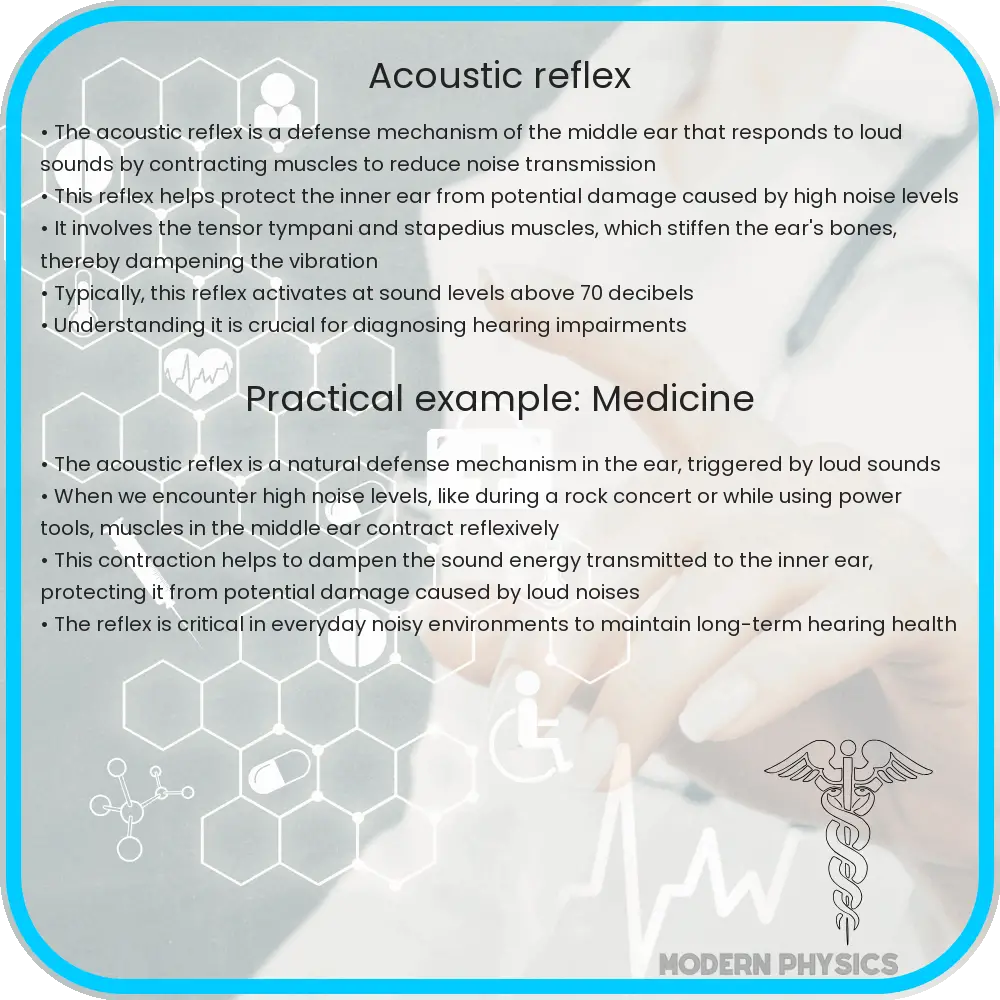Learn about the acoustic reflex, a protective mechanism in the ear that helps reduce the transmission of loud noises to the inner ear, and its role in auditory health.

Understanding the Acoustic Reflex in Hearing
The acoustic reflex, also known as the stapedial reflex or middle ear reflex, is an essential function of the human auditory system. It involves a rapid contraction of the stapedius and tensor tympani muscles in the middle ear in response to high-intensity sound stimuli. This reflex plays a critical role in hearing protection, as well as in the diagnosis of various auditory and neural conditions.
Hearing Function and Protective Role of the Acoustic Reflex
The primary purpose of the acoustic reflex is to protect the inner ear from potential damage caused by loud sounds. When high-intensity sound waves reach the auditory system, the stapedius and tensor tympani muscles contract. This contraction stiffens the ossicular chain (which includes the malleus, incus, and stapes—tiny bones in the middle ear), reducing the amount of vibration transmitted to the cochlea. As a result, the overall loudness of the sound is diminished, safeguarding the delicate structures within the inner ear.
In addition to its protective function, the acoustic reflex also plays a role in improving auditory perception in noisy environments. By selectively reducing the transmission of loud background noises, the reflex helps to enhance the clarity and distinction of foreground sounds, which is particularly important during conversations in a noisy setting.
Diagnostic Tool: Using the Acoustic Reflex
The measurement of the acoustic reflex threshold (the minimum sound level that triggers the reflex) is an integral part of audiological evaluations. This assessment helps clinicians diagnose various auditory pathologies. For instance, an absent or elevated acoustic reflex threshold can indicate issues such as:
- Conductive hearing loss
- Neuropathies affecting the auditory nerve or facial nerve
- Otosclerosis (a condition affecting the stapes bone in the middle ear)
- Certain types of tumors, such as acoustic neuromas
In clinical settings, the acoustic reflex is typically measured using an instrument called an impedance audiometer. This device produces sounds at various frequencies and intensities to elicit the reflex, while simultaneously measuring how sound energy is transmitted through the middle ear.
Reflex Pathways: How the Acoustic Reflex Works
The pathway of the acoustic reflex involves several key components of the auditory system. When a high-intensity sound is detected by the cochlea, it sends signals to the brainstem via the cochlear nerve. Specifically, the information is processed in the cochlear nucleus and then relayed to the superior olivary complex, which plays a crucial role in sound localization and reflexive responses to sound.
From the superior olivary complex, signals are sent to the motor nuclei of the facial nerves, which innervate the stapedius muscle, and to the trigeminal motor nucleus, which controls the tensor tympani muscle. Activation of these muscles leads to the contraction that modifies the stiffness of the ossicular chain, thus implementing the acoustic reflex.
The pathway not only involves direct routes from the auditory nerve to the muscles but also includes various feedback and modulation mechanisms involving the auditory cortex and other regions of the brain. These mechanisms are essential for the fine-tuning of the reflex, ensuring that it is triggered only by sounds that are genuinely excessive and potentially harmful.
Recent Advances and Research in Acoustic Reflex Studies
Continual advancements in technology and research are shedding new light on the complexities of the acoustic reflex and its broader implications in the field of audiology and beyond. Innovations in imaging and diagnostics allow for more detailed understanding and measurements of the acoustic reflex pathway, leading to more precise treatments and intervention strategies.
Researchers are investigating how variations in the acoustic reflex among individuals may correlate with susceptibility to certain auditory disorders. Additionally, there is growing interest in exploring the reflex’s applications in newer domains such as neurology, where it might help in diagnosing neural diseases early, and occupational health, to better understand the impacts of prolonged exposure to noise in various industries.
Conclusion
The acoustic reflex is a key component of our auditory system, playing crucial roles in both the protection of our inner ear structures and in enhancing our ability to hear in noisy environments. Its utility as a diagnostic tool provides valuable insights into the state of our auditory health, and ongoing research continues to uncover further complexities and applications of this reflexive action.
The future holds promising potential for the development of refined diagnostic and therapeutic techniques that will better exploit our understanding of the acoustic reflex. With advancements in technology and deeper research, we could see improved outcomes for patients with hearing issues and expanded uses of acoustic reflex measurements in broader medical fields. Understanding and harnessing this natural defense mechanism not only helps preserve our auditory health but also opens new doors in medical science for preventing and treating a wide range of conditions.
